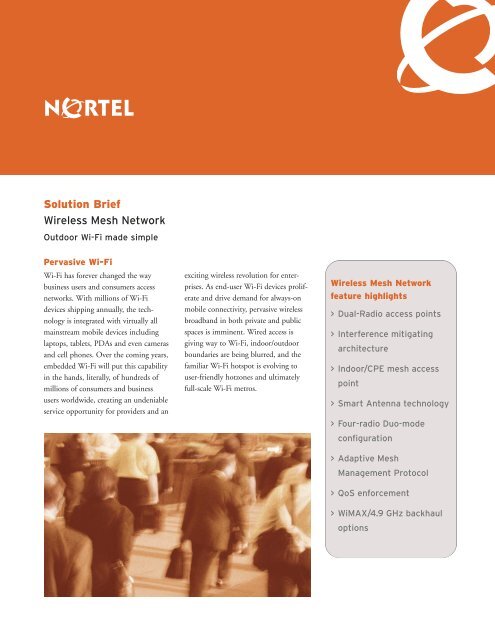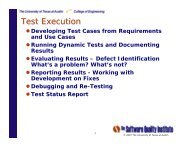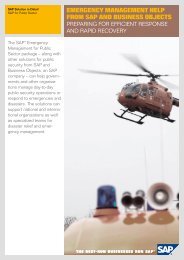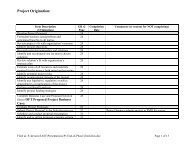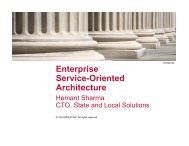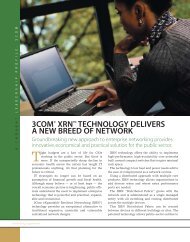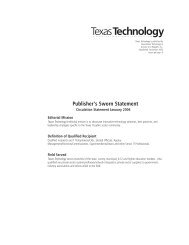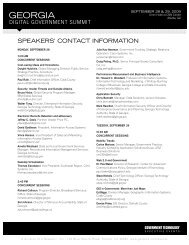Nortel Wireless Mesh Network - 1st Computer Networks
Nortel Wireless Mesh Network - 1st Computer Networks
Nortel Wireless Mesh Network - 1st Computer Networks
You also want an ePaper? Increase the reach of your titles
YUMPU automatically turns print PDFs into web optimized ePapers that Google loves.
Solution Brief<br />
<strong>Wireless</strong> <strong>Mesh</strong> <strong>Network</strong><br />
Outdoor Wi-Fi made simple<br />
Pervasive Wi-Fi<br />
Wi-Fi has forever changed the way<br />
business users and consumers access<br />
networks. With millions of Wi-Fi<br />
devices shipping annually, the technology<br />
is integrated with virtually all<br />
mainstream mobile devices including<br />
laptops, tablets, PDAs and even cameras<br />
and cell phones. Over the coming years,<br />
embedded Wi-Fi will put this capability<br />
in the hands, literally, of hundreds of<br />
millions of consumers and business<br />
users worldwide, creating an undeniable<br />
service opportunity for providers and an<br />
exciting wireless revolution for enterprises.<br />
As end-user Wi-Fi devices proliferate<br />
and drive demand for always-on<br />
mobile connectivity, pervasive wireless<br />
broadband in both private and public<br />
spaces is imminent. Wired access is<br />
giving way to Wi-Fi, indoor/outdoor<br />
boundaries are being blurred, and the<br />
familiar Wi-Fi hotspot is evolving to<br />
user-friendly hotzones and ultimately<br />
full-scale Wi-Fi metros.<br />
<strong>Wireless</strong> <strong>Mesh</strong> <strong>Network</strong><br />
feature highlights<br />
> Dual-Radio access points<br />
> Interference mitigating<br />
architecture<br />
> Indoor/CPE mesh access<br />
point<br />
> Smart Antenna technology<br />
> Four-radio Duo-mode<br />
configuration<br />
> Adaptive <strong>Mesh</strong><br />
Management Protocol<br />
> QoS enforcement<br />
> WiMAX/4.9 GHz backhaul<br />
options
Outdoor Wi-Fi<br />
Outdoor Wi-Fi deployments create<br />
unique challenges. WLANs are costprohibitive<br />
for massive-scale outdoor<br />
projects with coverage requirements that<br />
dwarf even the largest indoor implementations.<br />
Even administrators planning<br />
modest outdoor Wi-Fi projects need<br />
to contend with unique cabling and<br />
coverage challenges that reveal the<br />
inherent limitations of traditional WLAN<br />
architectures for outdoor deployments.<br />
The <strong>Nortel</strong> <strong>Wireless</strong><br />
<strong>Mesh</strong> <strong>Network</strong><br />
<strong>Nortel</strong>’s <strong>Wireless</strong> <strong>Mesh</strong> <strong>Network</strong> is a<br />
secure and highly scalable Wi-Fi solution<br />
that delivers low-cost wireless<br />
broadband for outdoor or expansive<br />
indoor areas. The <strong>Wireless</strong> <strong>Mesh</strong><br />
<strong>Network</strong> makes outdoor Wi-Fi viable<br />
and is designed to enable a new revenue<br />
opportunity for service providers or to<br />
enable enterprises to extend their private<br />
WLANs to outdoor areas.<br />
The <strong>Nortel</strong> <strong>Wireless</strong> <strong>Mesh</strong> <strong>Network</strong><br />
features three main elements —<br />
<strong>Wireless</strong> Access Points, <strong>Wireless</strong><br />
Gateways and the <strong>Wireless</strong> <strong>Mesh</strong><br />
Management platform.<br />
> The <strong>Wireless</strong> Access Points perform<br />
client access and traffic distribution<br />
functions. The dual-radio access points<br />
feature a unique inter-AP wireless<br />
transit capability with adaptive wireless<br />
mesh routing. Client access is<br />
802.11b/g in the 2.4 GHz spectrum<br />
and transit is carried over 802.11a<br />
in the 5GHz spectrum. Two models<br />
are available:<br />
<strong>Wireless</strong> Access Point 7220<br />
2<br />
Figure 1. The <strong>Wireless</strong> <strong>Mesh</strong> <strong>Network</strong> simplifies outdoor<br />
Wi-Fi deployments<br />
<strong>Mesh</strong> architecture<br />
<strong>Mesh</strong> AP<br />
Figure 2. <strong>Wireless</strong> <strong>Mesh</strong> <strong>Network</strong> radio architecture<br />
1<br />
Mobile<br />
Node<br />
2<br />
<strong>Wireless</strong><br />
AP 7220<br />
Mobile<br />
Node<br />
Existing utility pole<br />
or wall offering<br />
elevated mounting<br />
positions<br />
Coverage of the Access Link from the <strong>Wireless</strong> AP<br />
Mobile<br />
Node<br />
Table 1. WLAN and <strong>Mesh</strong> for outdoor deployments<br />
WLAN architecture<br />
Switch<br />
WLAN <strong>Mesh</strong><br />
Wiring requirements High — every AP Low — few APs<br />
Wired port: AP ratio 1:1 1:Many<br />
Mounting options Few — power/cabling Many — power only<br />
None line-of-site No Yes, using meshed APs<br />
Service distance from port
—The <strong>Wireless</strong> Access Point 7220<br />
can be deployed indoors or<br />
outdoors and features a rugged,<br />
weather-proof housing with integrated<br />
smart antennas. A new Duomode<br />
option allows two 7220s to<br />
be co-located and cross-connected<br />
for a four-radio co-coordinated<br />
configuration that doubles radio<br />
resources for both transit and access<br />
links to improve throughput and<br />
allow for lower latency.<br />
—<strong>Wireless</strong> Access Point 7215 is a<br />
cost-effective indoor access point<br />
that can be deployed as a fixed CPE<br />
device for mesh-based broadband<br />
wireless service, or as a seamless<br />
indoor extension for enterprise<br />
deployments. The <strong>Wireless</strong> Access<br />
Point 7215 can connect to the<br />
network via a wired Ethernet<br />
connection or wireless transit link<br />
with other 7220/7215 WAPs.<br />
<strong>Wireless</strong> Access Point 7215<br />
> <strong>Wireless</strong> Gateways logically connect<br />
the mesh network IP Subnet(s) to the<br />
enterprise’s wired network, or the<br />
service provider’s distribution network,<br />
and are responsible for routing, mesh<br />
transit link security, stateful firewalling<br />
and wireless user mobility.<br />
—<strong>Wireless</strong> Gateway 7250 features<br />
security acceleration hardware, dual<br />
10/100 Ethernet interfaces with<br />
expansion slots, and support for up<br />
to 120 <strong>Wireless</strong> Access Points.<br />
—<strong>Wireless</strong> Gateway 7240 features<br />
dual 10/100 Ethernet interfaces and<br />
supports up to 10 <strong>Wireless</strong> Access<br />
Points.<br />
Figure 3. An indoor <strong>Wireless</strong> Access Point 7215 enables seamless<br />
roaming between indoors and outdoors<br />
1<br />
<strong>Wireless</strong><br />
AP 7215<br />
802.11b/g Access Link —<br />
indoor coverage<br />
Mobile<br />
Node (MN)<br />
> The <strong>Wireless</strong> <strong>Mesh</strong> Management<br />
System is an enhanced version of<br />
<strong>Nortel</strong>’s ubiquitous Enterprise<br />
<strong>Network</strong> Management System —<br />
a common management platform<br />
shared among a wide breadth of<br />
<strong>Nortel</strong> wireless and wired networking<br />
products. The system provides a<br />
centralized utility for monitoring and<br />
managing wireless mesh network<br />
operations, including:<br />
—Discovery and visualization of<br />
<strong>Wireless</strong> Access Points, <strong>Wireless</strong><br />
Gateways and <strong>Wireless</strong> Bridges<br />
—Visualization of mesh routes<br />
—WAP status monitoring, event<br />
logging and alarms<br />
—Fault management including<br />
capturing and logging of traps<br />
and faults<br />
—Real-time performance metrics<br />
logging including utilization,<br />
error rates<br />
—Provides an intuitive user interface<br />
for monitoring and reporting<br />
2<br />
802.11a Transit link<br />
Indoor <strong>Mesh</strong> APs support two deployment models:<br />
<strong>Wireless</strong><br />
AP 7220<br />
802.11b/g Access Link —<br />
outdoor coverage<br />
1 Traditional WLAN architecture — using direct wired Ethernet connectivity<br />
Transit link<br />
2 <strong>Wireless</strong> <strong>Mesh</strong> <strong>Network</strong> architecture — using wireless transit via the neighboring<br />
<strong>Mesh</strong> <strong>Wireless</strong> APs<br />
Flexible mesh backhaul<br />
options<br />
A benefit of the mesh network architecture<br />
is that each wired access point can<br />
share its Ethernet connection among<br />
the meshed WAPs. Additional wired APs<br />
can be added to provide resiliency, or<br />
to improve throughput by decreasing<br />
the number of transit link hops to the<br />
wired network. Locations where wiring<br />
is possible are typically limited, representing<br />
the most restrictive planning<br />
parameter in any installation. <strong>Nortel</strong><br />
offers flexible mesh backhaul options<br />
that overcome this restriction and can<br />
greatly expand deployment opportunities,<br />
reach and the service potential of<br />
the mesh network.<br />
> The <strong>Wireless</strong> Bridge 7230 is deployed<br />
in pairs to create a long-range wireless<br />
link and to provide a wireless network<br />
access point for the mesh group. The<br />
bridge can be configured to operate in<br />
the 5 GHz unlicensed spectrum, or<br />
the 4.9 GHz licensed public safety<br />
band to create low-cost, high-capacity<br />
line-of-site wireless links for rapid<br />
deployment of Ethernet links.<br />
3
The WiMAX BTS portfolio features<br />
modular base transceiver stations<br />
(BTS) and remote terminals to establish<br />
high-bandwidth, long-range<br />
WiMAX backhaul links in both<br />
licensed and unlicensed spectrums<br />
without line-of-site restrictions.<br />
4<br />
<strong>Wireless</strong> Bridge 7230<br />
on pole mount<br />
Figure 4. <strong>Wireless</strong> <strong>Mesh</strong><br />
<strong>Network</strong> backhaul options<br />
Simplifying mesh<br />
deployments<br />
<strong>Nortel</strong>’s Adaptive <strong>Mesh</strong> Management<br />
Protocol is an integral component of the<br />
mesh access point operating system and<br />
has been developed solely to simplify<br />
the deployment and operation of mesh<br />
networks and optimize its performance<br />
and availability. Key functions include:<br />
> Auto-discovery of neighboring access<br />
points and available routing paths<br />
upon initial boot cycle<br />
> Auto-configuration and system<br />
synchronization without manual<br />
intervention<br />
> Radio Resource Management featuring<br />
auto-channel negotiation and<br />
assignment with neighboring access<br />
points to minimize the effects of<br />
interference<br />
> Smart Antenna management to<br />
control a sophisticated six-panel integrated<br />
directional antenna array for<br />
optimized transmission quality<br />
and data rates<br />
1<br />
Wired network<br />
2<br />
<strong>Wireless</strong><br />
Bridge<br />
7230<br />
3<br />
WiMAX<br />
BTS<br />
> Dynamic mesh routing to establish<br />
available mesh routing paths, monitor<br />
their performance and self-optimize<br />
when better performing paths become<br />
available<br />
> Fast fault recovery to ensure service<br />
resiliency by dynamically re-routing<br />
in the event of access point failure<br />
<strong>Nortel</strong>’s leadership in<br />
mesh networking<br />
Interference mitigation — The most<br />
destructive phenomenon for wireless<br />
networks is interference. <strong>Nortel</strong>’s dualradio<br />
design uses different spectrums for<br />
transit and access to enable high-density<br />
deployments without the self-interfering<br />
limitations of single-radio designs.<br />
<strong>Nortel</strong>’s Adaptive <strong>Mesh</strong> Management<br />
Protocol allows access points to survey<br />
RF characteristics, share information<br />
with neighbors and negotiate the transit<br />
link channel configuration that delivers<br />
the best signal and data rates. <strong>Nortel</strong>’s<br />
exclusive Smart Antenna technology<br />
intelligently controls multiple integrated<br />
directional antennas and establishes<br />
transit link beams that don’t interfere<br />
with non-targeted neighbors.<br />
1 WAP with direct wiring to network<br />
<strong>Nortel</strong> offers multiple<br />
backhaul options that<br />
greatly expand deployment<br />
opportunities for<br />
both service providers<br />
and private enterprises.<br />
2a <strong>Wireless</strong> Bridge 7230 operating in unlicensed 5.8 GHz band<br />
2b <strong>Wireless</strong> Bridge 7230 operating in licensed 4.9 GHz public<br />
safety band<br />
3a WiMAX BTS supporting 802.16d “fixed” WiMAX service<br />
3b WiMAX BTS supporting 802.16e “mobile” WiMAX service
Stronger security — Expansive mesh<br />
networks rely on transit and backhaul<br />
links that traverse public spaces, creating<br />
an opportunity for hackers to intercept<br />
transmissions. <strong>Nortel</strong> goes beyond the<br />
standards-based WEP/WPA/WPA2<br />
access link security and addresses this<br />
transit link threat. <strong>Nortel</strong> delivers proven<br />
IPSec security for transit links — a<br />
method derived from <strong>Nortel</strong>’s trusted<br />
VPN technology that already secures<br />
hundreds of millions of business users.<br />
When the secure tunnel terminates on<br />
the wireless gateway, a stateful firewall<br />
filters authorized traffic to the wired<br />
network and ensures that control systems<br />
are inaccessible to mobile users.<br />
Greater scalability — <strong>Nortel</strong>’s Adaptive<br />
<strong>Mesh</strong> Management Protocol allows operators<br />
to add capacity by simply adding<br />
another mesh access point into the<br />
targeted coverage zone. New <strong>Wireless</strong><br />
Access Points auto-discover their neighbors,<br />
negotiate the cleanest channels,<br />
and establish and maintain optimized<br />
routes. If performance-impacting transit<br />
bottlenecks are identified, they can be<br />
relieved by <strong>Nortel</strong>’s <strong>Wireless</strong> Access Point<br />
7220 Duo-mode configuration that effectively<br />
doubles available radio resources<br />
to support extended multi-hop paths,<br />
with reduced latency and greater<br />
throughput.<br />
Simplicity — <strong>Nortel</strong>’s exclusive Smart<br />
Antenna technology lets operators take<br />
advantage of the range, throughput and<br />
spectral efficiency benefits of high gain<br />
directional antenna without the operational<br />
burden of manual installation,<br />
alignment or maintenance of typical<br />
external antenna designs. Autodiscovery,<br />
auto-configuration and selfhealing<br />
capabilities simplify installation<br />
and ongoing management.<br />
Service resiliency — <strong>Nortel</strong>’s Smart<br />
Antenna technology, combined with<br />
separation of access and transit spectrums,<br />
means that overlapping cells can<br />
Unique features<br />
> Dual-radio AP design for dedicated access and transit<br />
> Duo-mode configuration enables up to four radios at a single<br />
installation location<br />
> 802.11 b/g access and 802.11a transit service<br />
> WiMAX/4.9 GHz backhaul options<br />
> <strong>Nortel</strong> Adaptive <strong>Mesh</strong> Management Protocol simplifies operations and<br />
optimizes performance<br />
> Seamless roaming among all mesh access points<br />
> QoS enforcement for voice and multimedia<br />
> Access links secured with WEP/WPA/WPA2<br />
> Transit links secured with IPSec<br />
> Virtual service groups with discrete service profiles for up to eight SSIDs<br />
> Smart Antenna technology, with an integrated switched-beam six-panel<br />
directional antenna array, optimizes backhaul data rates<br />
> <strong>Wireless</strong> Access Point 7215 enables seamless indoor/outdoor roaming<br />
> Integrated stateful firewall ensures traffic isolation<br />
> Bandwidth reservation maintains QoS during peak loads<br />
> Comprehensive centralized management<br />
> Statistics logging and reporting<br />
> Distributed routing intelligence<br />
> Fault-recovery in event of AP failure<br />
> Packet prioritization for differentiated services<br />
> Dynamic mesh routing establishes optimal routes<br />
> Radio Resource Management with auto-channel negotiation limits<br />
interference<br />
> Power-only installation without Ethernet cabling<br />
> Auto-configuration and verification<br />
> Auxiliary Ethernet port for device integration<br />
be deployed to provide service resiliency<br />
at the client access level. Should an access<br />
point fail, <strong>Nortel</strong>’s Adaptive <strong>Mesh</strong><br />
Management Protocol allows the system<br />
to recognize the failure and dynamically<br />
re-route to the best alternative path. For<br />
the most resilient installations, the 7220<br />
Duo-mode configuration provides the<br />
access and transit radio resiliency of a<br />
chassis-based system but removes the<br />
risk of shared components to provide<br />
full redundancy for antennas and power<br />
supplies alike. The innovative design of<br />
the <strong>Wireless</strong> Access Point 7220 provides<br />
resistance to the elements — minimal<br />
external wiring removes an inviting<br />
vulnerability and the integrated Smart<br />
Antennas will auto-recover should the<br />
access point be knocked out of alignment<br />
under severe conditions.<br />
5
Figure 5. <strong>Wireless</strong> <strong>Mesh</strong> <strong>Network</strong> solution for low-cost outdoor Wi-Fi coverage<br />
<strong>Wireless</strong><br />
<strong>Mesh</strong><br />
Management<br />
System<br />
Quality of Service — <strong>Nortel</strong>’s <strong>Wireless</strong><br />
<strong>Mesh</strong> <strong>Network</strong> supports differentiated<br />
services, including voice and multimedia<br />
by dynamically reserving transit link<br />
bandwidth and enforcing packet prioritization.<br />
QoS support removes the<br />
utility and service constraints of dataonly<br />
solutions.<br />
Flexible deployment options — Each<br />
outdoor deployment is unique. <strong>Nortel</strong>’s<br />
dual-radio WAP and 5 GHz transit link<br />
architecture opens up deployment possibilities<br />
by removing the proximity and<br />
density constraints of single-radio<br />
designs. The unique integrated six-panel<br />
directional antenna array delivers highquality<br />
transit links that are tolerant of<br />
steep elevation changes between hops.<br />
And because wired network access points<br />
are hard to come by and costly to deploy,<br />
<strong>Nortel</strong> gives planners the freedom of<br />
deploying mesh networks many miles<br />
from the wired network access point<br />
6<br />
Core network<br />
<strong>Wireless</strong><br />
Gateway 72XX<br />
Distribution network<br />
WiMAX BTS<br />
WiMAX BTS<br />
Indoor campus<br />
<strong>Wireless</strong> Access<br />
Point 7215<br />
<strong>Wireless</strong><br />
Access<br />
Point 7220<br />
using the <strong>Wireless</strong> Bridge 7230 or<br />
WiMAX backhaul options, using either<br />
licensed or unlicensed bands.<br />
Lower cost — <strong>Nortel</strong>’s <strong>Wireless</strong> <strong>Mesh</strong><br />
<strong>Network</strong> is optimized to deliver lowcost<br />
wireless broadband services over<br />
expansive areas. An innovative wireless<br />
transit architecture and flexible backhaul<br />
options keep wiring requirements and<br />
> Secure and resilient Wi-Fi service<br />
> More installation, coverage and service options<br />
> Interference mitigating architecture<br />
> Simple, low cost and scalable<br />
Outdoor campus<br />
Public Wi-Fi<br />
Service<br />
<strong>Wireless</strong> Access<br />
Point 7215<br />
Indoor<br />
CPE<br />
costs at a minimum. Where high<br />
throughput and low latency upgrades<br />
are required, the 7220 Duo-mode technology<br />
allows for easier installation than<br />
chassis-based upgrades, and Smart<br />
Antenna technology streamlines initial<br />
deployment, requiring fewer on-site<br />
technicians and fewer truck rolls.<br />
Real-life deployment of <strong>Nortel</strong> <strong>Wireless</strong><br />
<strong>Mesh</strong> <strong>Network</strong> solution
<strong>Wireless</strong> Access Point 7220 — Technical specifications<br />
<strong>Wireless</strong> AP 7220 Access Link<br />
802.11b/g (2.4 GHz) Radio System<br />
Center frequency<br />
• 2417 MHz to 2457 MHz (i.e., North<br />
America)<br />
Data rate: 54 Mbps max<br />
• Supports 1, 2, 5.5, 11 Mbps (IEEE 802.11b)<br />
• Supports 6, 9, 12, 18, 24, 36, 48 and<br />
54 Mbps (IEEE 802.11g)<br />
• IEEE 802.11b/g standard rates<br />
Access antenna options<br />
• Co-linear whip, 5 dBi nominal antenna,<br />
SMA connectors<br />
• PIFA integrated antenna, 0 dBi nominal<br />
SMA connectors<br />
Radiated EIRP<br />
• +26 dBm typical<br />
Receive sensitivity 802.11b (11 Mbps)<br />
• -95 dBm typical @ 11 Mbps<br />
• -96 dBm typical @ 5.5 Mbps<br />
• -98 dBm typical @ 2 Mbps<br />
• -101 dBm typical @ 1 Mbps<br />
Receive sensitivity 802.11g (54 Mbps)<br />
• -80 dBm typical @ 54 Mbps<br />
• -82 dBm typical @ 48 Mbps<br />
• -86 dBm typical @ 36 Mbps<br />
• -90 dBm typical @ 24 Mbps<br />
• -92 dBm typical @ 18 Mbps<br />
• -95 dBm typical @ 12 Mbps<br />
• -95 dBm typical @ 9 Mbps<br />
• -96 dBm typical @ 6 Mbps<br />
<strong>Wireless</strong> AP 7220 Transit Link 802.11a<br />
(5 GHz) radio system<br />
Center frequency<br />
• 5740 MHz to 5840 MHz<br />
Data rate: 54 Mbps max<br />
• Supports 6, 9, 12, 18, 24, 36, 48 and<br />
54 Mbps<br />
• IEEE 802.11a standard rates<br />
Antenna system gain from radio module<br />
card inside the unit<br />
• 8.4 dBi nominal<br />
Radiated EIRP<br />
• +28 dBm typical @ 54 Mbps<br />
• +30 dBm typical @ 48 Mbps<br />
• +32 dBm typical @ 6-36 Mbps<br />
Radiated EIRP (802.11a)<br />
• +28 dBm typical @ 54 Mbps<br />
• +30 dBm typical @ 48 Mbps<br />
• +32 dBm typical @ 6-36 Mbps<br />
Receive sensitivity ( 0°C<br />
= 8W typical<br />
Outdoor < 0°C = 8W – 14W (- 40°C)<br />
– Startup: Indoor or outdoor > 0°C = 8W<br />
typical<br />
Outdoor < 0°C = 24W (short duration)<br />
8W – 14W (- 40°C)<br />
• Dimensions (without mounting brackets or<br />
antennas)<br />
– 265mm (10.5 inches) tall x 200mm<br />
(8 inches) diameter<br />
• Weight: 2.4 kg (5.3 lbs)<br />
• Color: Gray<br />
Optional accessories<br />
• Mounting brackets (right-angle or straight<br />
horizontal attachment)<br />
• 5m, CAT5 Ethernet indoor/outdoor<br />
rated cable for network access point (NAP)<br />
operation<br />
• Street light photo-electric control power tap<br />
‘luminaire’ 120/208/240 V<br />
• 13dBi, 18dBi and 23dBi TL external<br />
antennae<br />
<strong>Wireless</strong> Bridge 7230 –<br />
Technical specifications<br />
Radio frequency<br />
• 4.940 GHz to 4.990 GHz<br />
• 5.470 GHz to 5.725 GHz<br />
• 5.725 GHz to 5.850 GHz<br />
Data rate<br />
• Up to 48 Mbps, user-configurable<br />
Transmit power<br />
• 4.9 GHz: 10 dBm (max)<br />
• 5.4 GHz: 7 dBm (max)<br />
• 5.8 GHz: 17 dBm (max)<br />
Physical specifications<br />
• Depth: 2.3 in. (5.8 cm)<br />
• Width: 12 in. (30.5 cm)<br />
• Height: 12 in. (30.5 cm)<br />
• Weight: 3.3 lb. (1.5 kg)<br />
Operating environment specifications<br />
• Outdoor unit and external antenna<br />
• Enclosure: all-weather case<br />
• Temperature: -31°– 140°F (-35°– 60°C)<br />
7
In the United States:<br />
<strong>Nortel</strong><br />
35 Davis Drive<br />
Research Triangle Park, NC 27709 USA<br />
In Canada:<br />
<strong>Nortel</strong><br />
195 The West Mall<br />
Toronto, Ontario M9C 5K1 Canada<br />
In Caribbean and Latin America:<br />
<strong>Nortel</strong><br />
1500 Concorde Terrace<br />
Sunrise, FL 33323 USA<br />
<strong>Nortel</strong> is a recognized leader in delivering communications capabilities that enhance<br />
the human experience, ignite and power global commerce, and secure and protect the<br />
world’s most critical information. Our next-generation technologies, for both service<br />
providers and enterprises, span access and core networks, support multimedia and<br />
business-critical applications, and help eliminate today’s barriers to efficiency, speed<br />
and performance by simplifying networks and connecting people with information.<br />
<strong>Nortel</strong> does business in more than 150 countries. For more information, visit <strong>Nortel</strong><br />
on the Web at www.nortel.com.<br />
For more information, contact your <strong>Nortel</strong> representative, or call 1-800-4 NORTEL<br />
or 1-800-466-7835 from anywhere in North America.<br />
<strong>Nortel</strong>, the <strong>Nortel</strong> logo, <strong>Nortel</strong> Business Made Simple and the Globemark are trademarks<br />
of <strong>Nortel</strong> <strong>Network</strong>s. All other trademarks are the property of their owners.<br />
Copyright © 2006 <strong>Nortel</strong> <strong>Network</strong>s. All rights reserved. Information in this document<br />
is subject to change without notice. <strong>Nortel</strong> assumes no responsibility for any<br />
errors that may appear in this document.<br />
N N 1 0 6 4 8 1 - 0 1 1 2 0 7<br />
In Europe:<br />
<strong>Nortel</strong><br />
Maidenhead Office Park, Westacott Way<br />
Maidenhead Berkshire SL6 3QH UK<br />
In Asia:<br />
<strong>Nortel</strong><br />
United Square<br />
101 Thomson Road<br />
Singapore 307591<br />
Phone: (65) 6287 2877<br />
> BUSINESS MADE SIMPLE


